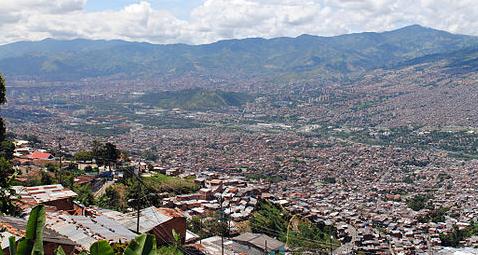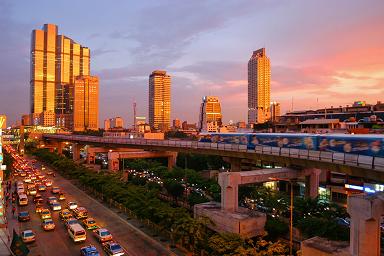The WBCSD Urban Infrastructure Initiative
It has become clearer than ever that cities are key to driving real action on climate change. One of the most prominent features of cities is that they are taking action now, regardless of what happens in global negotiations, involving both public and private sectors. The WBCSD’s groundbreaking Urban Infrastructure Initiative (UII) has shown how effectively the collaboration between cities and business can work.
By 2050, 70 per cent of the world’s population will live in cities; and cities are where the battle for a sustainable future for humanity will be won or lost. City governments around the world are rising to this challenge by pursuing ambitious sustainability visions that will make them more competitive, resource efficient, resilient and inclusive.
The role of city governments is increasingly recognised within international negotiations as cities become key ‘non-state actors’. In addition, business is aware of the exciting opportunity city–business collaboration represents and an increasing number of leading solution providers are working to make low-carbon cities a reality. The WBCSD works to catalyse business innovation and action for low-carbon cities.
Latin American responses
With COP20 taking place in Lima, Peru, it is an interesting moment to focus on Latin America. With 80 per cent of its population living in cities today, Latin America is more urbanised than any other region in the developing world. This share is expected to rise to 85 per cent by 2025.
The shift from country to town has contributed significantly to Latin America’s growth, as economies of scale have boosted the productivity of expanding cities and reduced the cost of delivering basic services to their inhabitants. Despite this positive progress, important complex challenges remain, often linked to the negative consequences of rapid growth such as congestion, air quality problems, social exclusion and public safety issues. Recent extreme weather events have also highlighted the vulnerability of urban centres across the region to a changing climate.
Luckily, there are excellent examples among Latin American cities making real progress on addressing these challenges. The recent transformation of Medellin in Colombia (pictured right), the successful development of the Bogota Bus Rapid Transit system, and the City of Rio’s Intelligent Operations Center are developments that cities from all over the world come to learn from.
The need for a broad approach
Yet addressing complex sustainability issues in practice remains a daunting challenge for city leaders. Solutions often necessitate major transformations in a city’s infrastructure systems – including buildings, energy, mobility, telecommunications, water, sanitation and waste management services – and optimising the links between these systems.
These challenges are coming at a time when cities face major difficulties in financing infrastructure, particularly in view of the constraints on public sector resources and commercial debt in the wake of the financial crisis. A 2013 report from McKinsey, Infrastructure Productivity: how to save US$1 trillion a year, estimates that the world will require US$57 trillion in infrastructure investment to 2030 – more than the current value of the worlds’ existing infrastructure – with the majority of investment needed in urban centres.
This a global issue: as advanced economies need to maintain and replace ageing infrastructure, fast-growing cities in the developing world need major investments to be able to provide basic levels of service to their rapidly growing populations.
Many leading businesses are building their long-term strategies around providing integrated solutions to complex problems facing the world’s cities.
Furthermore, a system-wide perspective becomes particularly important as new infrastructure technologies evolve and become increasingly connected. For example, many cities are experiencing the simultaneous deployment of low- or zero-energy buildings, renewable energy technologies suitable for the urban environment, the development of smart electrical grids, and the growing market uptake of electrically-charged vehicles. Individually, such developments can generate opportunities for major reductions in energy use and emissions while improving resilience. However, these elements are inter-linked and their co-evolution needs to be considered holistically if cities are to fully optimise the overall benefits of evolving low-carbon urban infrastructure systems.
Forward-looking companies that are committed to sustainability and experienced in delivering effective solutions can help cities navigate these challenges and turn a high-level vision into practical and implementable action plans. Business can play a vital role not only in providing specific infrastructure, technology, services and financing solutions, but also in contributing to the definition of the strategy that will support the overall optimisation of urban systems to drive sustainability.
Many leading businesses are building their long-term strategies around providing integrated solutions to complex problems facing the world’s cities. A number of these solution types are focused on improving the efficiency of existing infrastructure (e.g. smart grids, smart water networks, intelligent transport systems) hence delivering major environmental benefits, improved operational performance, while avoiding or delaying the need for new major capital investments.
Early engagement of the private sector
Cities have long sourced solutions and services from the private sector and have engaged businesses to design, build, operate and maintain major infrastructure. However, under this traditional model, businesses are generally involved at a later stage in the city’s planning/implementation life cycle, when the opportunities to promote innovation and provide valuable strategic input are limited.
A major missed opportunity
While there are already excellent examples of cities and business working together at the strategic level, this is the exception rather than the rule, representing a major missed opportunity. The WBCSD strongly believes that cities and businesses need to develop new models of collaboration early in the planning process with a view to leverage the full capability of the private sector to drive innovative solutions and support effective decision-making.
There are several common factors that appear to limit early engagement with businesses, including:
Lack of suitable engagement processes. Cities may not have processes in place that enable strategic engagement with business early in the planning cycle, or they may be unsure of how such a process could be established or integrated into existing regulations or stakeholder engagement and planning processes.
The UII brings together 14 leading WBCSD member companies with an array of knowledge and skills to help unlock opportunities for urban authorities to create cities that are more sustainable
Perception of biased input. City officials may not have full confidence that business representatives will give input that is in the city’s best interests and assume that they will use an engagement only as means to pursue their own commercial interests.
Regulatory constraints. Regulations – in particular those relating to public procurement – can limit interactions between cities and the private sector. Such regulations are intended to ensure the integrity and effectiveness of public procurement and planning processes. However, these rules (or more importantly, how they are applied and perceived in practice) may have the unintended consequence of losing valuable input from business that could benefit the city and its citizens.
The WBCSD established the UII to advance the urban sustainability agenda by showcasing the critical role that business can play as a solution provider, and by constituting a platform for collaborative strategic engagement between cities and business. The UII brings together 14 leading WBCSD member companies with an array of knowledge and skills to help unlock opportunities for urban authorities to create cities that are more sustainable, efficient and livable.
This multi-sector, multi-company group worked with the following leading cities: Turku (Finland); Tilburg (The Netherlands); Ahmedabad, Rajkot, Surat and Vadodara in Gujarat State (India); Yixing (China); Kobe (Japan); Guadalajara (Mexico); and Philadelphia (USA).
In each city, the UII mobilised a multi-disciplinary team of company experts to work collaboratively with senior city officials. These teams took an integrated, cross-sector approach to analysing the city’s major sustainability challenges and to developing an innovative ‘solutions landscape’ (i.e. a portfolio of practical solutions) to address these challenges. These engagements were facilitated by respected ‘bridging organisations’ including ICLEI – Local Governments for Sustainability, and the Urban Land Institute.
While the UII is a pilot project that has worked with a relatively small number of leading cities, the recently-published UII Final Report summarises the evidence – particularly the perspectives of city leaders – which suggests that the early involvement of business can be of real benefit to any city administration aiming to advance sustainability. It has demonstrated how leading businesses can take a demand-driven and collaborative approach to understanding and addressing a city’s challenges, and can provide objective, technology- and vendor-neutral advice on potential solutions.
We are using this model for advancing collaboration on other key urban sustainability issues. The WBCSD Energy Efficiency in Buildings project has been working with major cities including Warsaw and Shanghai, convening key local stakeholders along the buildings value chain to diagnose and tackle key barriers to energy efficiency. Our Sustainable Mobility Project is collaborating with key demonstrator-cities – including Bangkok in Thailand (pictured left) and Campinas in Brazil – to support the development of their sustainable mobility plans, accelerating progress towards delivering universal access to safe and low-impact mobility for both goods and people.
Case study – UII in Latin America: Guadalajara (Mexico)
Guadalajara is Mexico’s second largest city, capital of the State of Jalisco and seat of the Municipality of Guadalajara. The Guadalajara Metropolitan Area includes six adjacent municipalities and has a total population of more than 4.4 million. City officials have a vision to transform the city into a modern, sustainable metropolis that offers a high quality of life.
A multi-company, multi-sector team from the UII with expertise worked with city officials over several months in 2012. Initial dialogue identified priorities towards a comprehensive vision to tackle inadequate public transport, the perception that Guadalajara is a violent, insecure city, depopulation of the centre, and inadequate waste handling.
These priorities represented four broad themes to be targeted during the collaboration. UII worked in a series of workshops to develop a total of 20 solutions across the four categories. They included:
- Expanding and modernising the public transport system
- Implementing an integrated traffic management system
- Establishing a citizen participation programme – GuadalajaraConvive
- Relocating dwellings in high-risk areas through a programme of low-cost housing
- Revitalising public spaces and urban facilities, and
- Segregating solid urban waste.
UII recognises that the different challenges cities face require strategies that respond to the interconnections. The team developed proposals using an integrated approach, with a system-wide view from the start. This approach generated cross-cutting solutions which tackle issues that either directly or indirectly contribute to the city’s overall transformation as well as handling specific topics.
Collaborating with city officials and other stakeholders active in Guadalajara’s urban development demonstrated the value of incorporating early business input into the city’s thinking. This enabled city representatives to consider a variety of ideas, and to engage with businesses collectively in a broad context – rather than just in relation to specific tenders. Francisco Ayón López, the mayor of Guadalajara during this project, commented: “The sustainability of cities cannot be achieved by isolated efforts, but requires the involvement of governments, society and business.
Together, we can develop high-impact integrated solutions that generate immediate results for the people ... Guadalajara has developed together with the WBCSD a transformation plan with a comprehensive, modern and far-reaching vision.” More information can be found in the UII Guadalajara Report (available in both Spanish and English): A Solutions Landscape for Guadalajara.
A win-win situation
In conclusion, the WBCSD sees an enormous win-win opportunity to drive transformational global action on climate change through bringing city and business leadership together – but early engagement is crucial for success. Cities will win by getting practical, cost-effective solutions to realise their ambitious sustainability visions. Leading businesses will win through growing markets for innovative new solutions that will be essential for delivering transformational change.
Leading businesses will win through growing markets for innovative new solutions that will be essential for delivering transformational change.
The UII has given a clear indication that this innovative new approach can address priority public policy objectives while increasing the likelihood that urban sustainability planning produces real shifts towards cost-effective low-carbon infrastructure pathways.
At the WBCSD, we are not stopping here. Based on the success and lessons of the UII, we are now building an ambitious new programme focusing on zero emissions cities. We will bring together innovative cities and leading solutions providers to collaborate towards making a city with no net emissions a reality. Watch this space.










